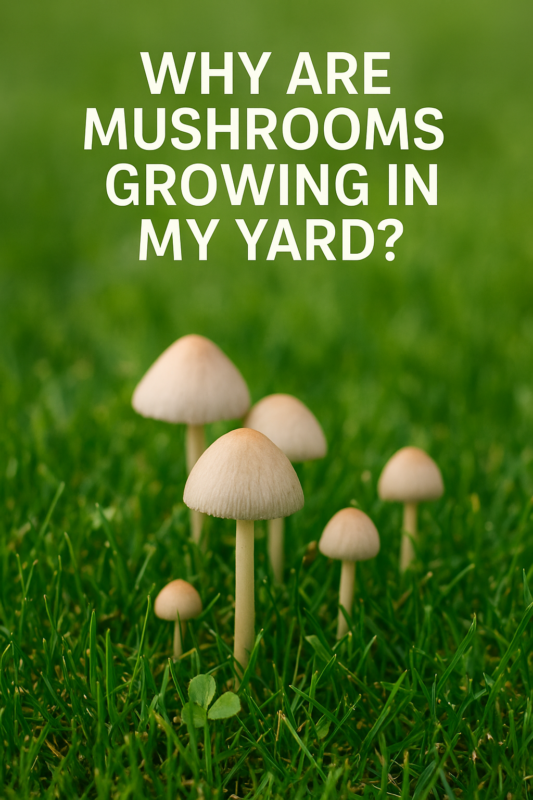
Why Are Mushrooms Growing in My Yard? An Expert’s Guide
If you’ve ever stepped outside after a rainy morning and spotted clusters of mushrooms popping up in your lawn, you’re not alone. Many homeowners ask me the same question: “Why are mushrooms growing in my yard?”
As a horticulturist and long-time mushroom grower, I can tell you that mushrooms are far more than random intruders—they’re a sign that something is happening beneath the soil. In this guide, we’ll explore why mushrooms appear, what they say about your lawn’s health, whether they’re dangerous, and how you should handle them.
First Things First: What Are Mushrooms?
Mushrooms are the fruiting bodies of fungi. They’re the reproductive structures that release spores, much like how flowers produce seeds. What you see on the surface is just a small part of a much larger organism.
Beneath the soil lies the mycelium, a vast network of fungal threads (hyphae) that can extend for meters or even miles. When the conditions are right—usually moisture, organic material, and shade—the mycelium produces mushrooms above ground.
So when you ask, “Why are mushrooms growing in my yard?”, the short answer is: because the underground fungus has found the perfect environment to fruit.
Common Reasons Mushrooms Grow in Your Yard
There are several factors that explain why mushrooms suddenly appear on lawns and gardens:
1. Moisture Levels Are High
Mushrooms thrive in damp environments. After heavy rain, irrigation, or even prolonged humidity, the mycelium underground pushes up fruiting bodies.
2. Organic Material in the Soil
Fungi decompose organic matter like buried wood, mulch, grass clippings, or tree roots. If your yard has decaying plant material, mushrooms will likely show up.
3. Healthy Soil Ecosystem
Surprisingly, mushrooms can be a sign of a thriving soil ecosystem. Fungi play a crucial role in nutrient cycling, breaking down organic matter and enriching the soil.
4. Shade and Shelter
Lawns with shaded areas under trees, fences, or buildings provide the perfect low-light environment mushrooms need.
5. Old Tree Roots
Even if you removed a tree years ago, its decomposing roots underground may serve as food for fungi, causing mushrooms to sprout for years.
Are Yard Mushrooms Dangerous?
One of the biggest concerns homeowners have is whether yard mushrooms are poisonous. The truth:
- Some mushrooms are toxic. It’s difficult to identify them without expertise. Species like Amanita can be lethal if ingested.
- Pets and children are at risk. Dogs, cats, and toddlers may be curious enough to eat them. If you’re not 100% sure, always remove suspicious mushrooms.
- Most mushrooms are harmless. They won’t damage your grass or trees; in fact, they often help your yard by improving soil health.
Important: Never eat mushrooms growing in your yard unless properly identified by a mycologist.
Should You Remove Mushrooms From Your Yard?
It depends on your goals:
- For Lawn Aesthetics: If you want a clean, mushroom-free yard, you can remove them manually.
- For Safety: If you have kids or pets, it’s wise to remove mushrooms as soon as they appear.
- For Soil Health: Leaving mushrooms alone won’t harm your yard. They naturally break down organic matter and enrich the soil.
How to Get Rid of Mushrooms in Your Yard
If you’re tired of mushrooms popping up, here are strategies that actually work:
- Remove Organic Debris
- Rake up leaves, grass clippings, and wood chips.
- Dig up decaying roots if possible.
- Improve Drainage
- Mushrooms love standing water. Aerate compacted soil and correct low spots where water collects.
- Increase Sunlight Exposure
- Trim tree branches or thin shrubs to reduce shade.
- Maintain Proper Lawn Care
- Mow regularly and don’t overwater.
- Mushrooms often disappear as the lawn dries out.
- Physical Removal
- Pick mushrooms as soon as you see them to prevent spore spread.
- Use gloves if unsure about toxicity.
My Personal Experience With Mushrooms in Yards
I often get calls from clients panicked about mushrooms overtaking their lawns. Once, a homeowner thought mushrooms were a sign of disease in their grass. In reality, it was an old maple tree root decaying underground. The fungi were simply doing their job—breaking it down naturally.
Another time, a neighbor’s dog got sick after eating a mushroom in their yard. Since then, I always advise pet owners to err on the side of caution and remove mushrooms quickly.
From my perspective, mushrooms are more of a symptom than a problem. They signal that your yard has organic matter decomposing—something that’s normal and even beneficial.
FAQs: Why Are Mushrooms Growing in My Yard?
Q: Do mushrooms mean my lawn is unhealthy?
Not at all! Mushrooms often mean your soil is rich in organic material.
Q: Will mushrooms kill my grass?
No, mushrooms don’t harm grass. They break down debris, which improves soil quality.
Q: Are mushrooms in my yard edible?
Unless identified by an expert, never eat mushrooms from your yard. Many toxic species look similar to edible ones.
Q: Why do mushrooms appear overnight?
Mycelium underground grows continuously. When conditions are right, mushrooms can sprout and mature in just hours.
Q: Can I permanently stop mushrooms from growing?
Not really. As long as organic material exists in your soil, mushrooms can return. You can minimize them, but complete prevention is nearly impossible.
Final Thoughts
So, why are mushrooms growing in your yard? Simply put, your soil has the perfect balance of moisture, organic matter, and shelter that fungi love. Far from being harmful, they’re usually a sign of a healthy ecosystem.
That said, if aesthetics or safety are concerns, you can remove mushrooms and reduce their recurrence with proper lawn care.
In the end, mushrooms are nature’s recyclers. They’re not invaders—they’re workers helping your yard thrive.